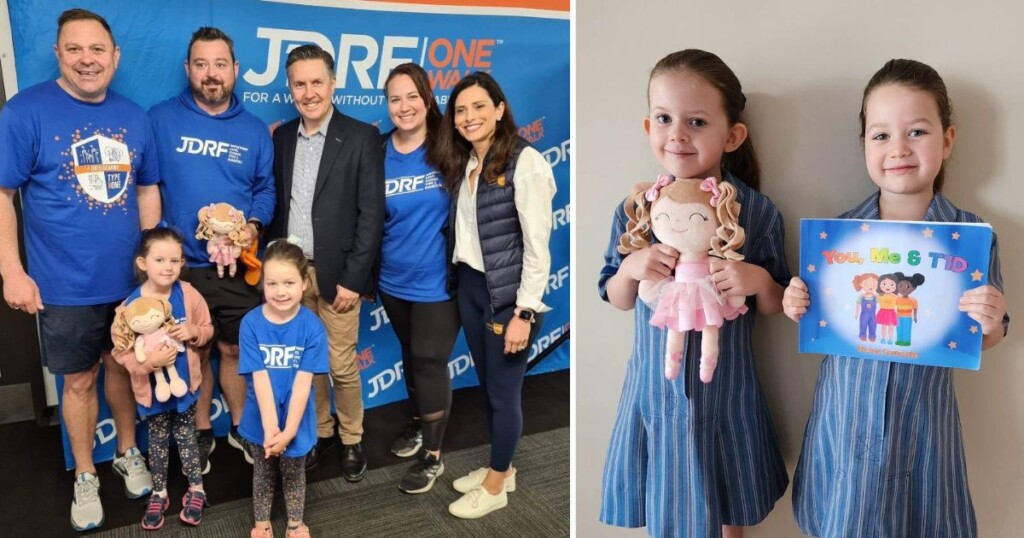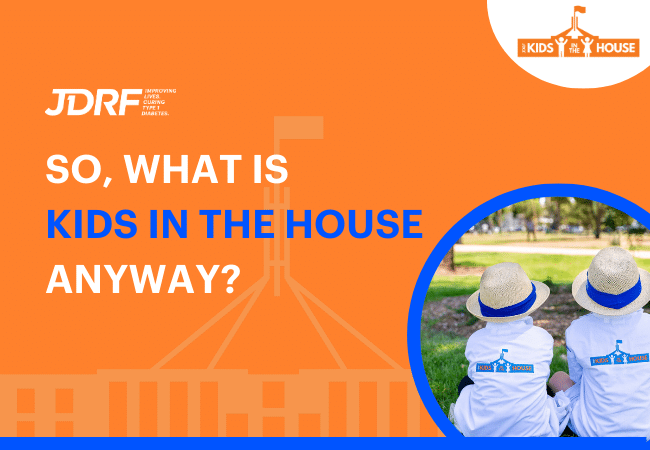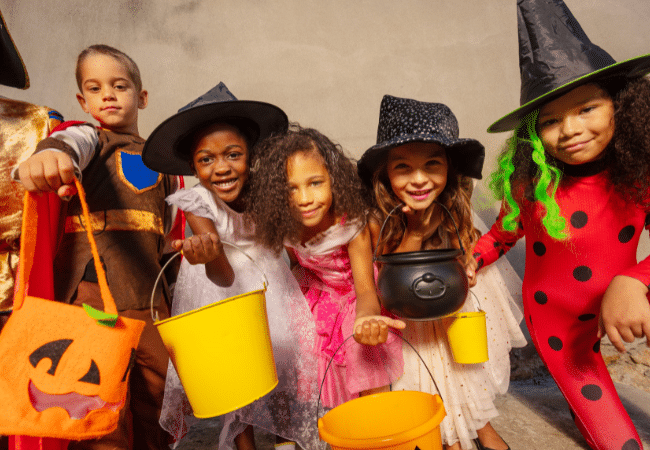Stacey and Adam: ‘We’ve built a strength you didn’t realise a family could have’


Stacey and Adam Constantini were busy parents of two girls when their youngest daughter, Georgia, was diagnosed with type 1 diabetes (T1D) at 10 months. Here they share their story, including how Stacey went on to write a series of books to help kids living with T1D (You, Me & T1D), how Adam was later diagnosed with LADA, and how they overcome challenges as a couple and a family.
(Top images: The family pre-diagnosis; Georgia when she was diagnosed; Adam and Georgia in hospital.)
Stacey’s story
Adam and I met at work in 2010. We got married in April 2016 and had Ivy in October; Ivy was only 17 months old when we had Georgie, so it was all very full on and we were happy.
In January 2019 we noticed Georgie had started wetting through her nappies. That week it was really hot here in Adelaide and she was loving her water, and we thought, ‘Fantastic, we’ve got a baby who likes water!’ Then I noticed that when we’d wake Georgie up for her bottle, she’d drink it all, but she’d be back asleep instantly.
We got a locum to come and they said it was probably just a virus. But that night I noticed when she exhaled it was making a weird sound. I said to Adam, “There’s something that’s not right”. We went down to emergency, and by the time we got there she was really floppy. They tested her blood straight away and said she’s got type 1 diabetes. She was only 10 months old.
The hospital staff were fantastic in sheltering us about how bad she was at that time. But looking back, she was in a horrific state. Her [blood glucose] levels and her ketones were off the charts. That whole time is still such a blur, four years later.
We were relieved our daughter was with us and that she could come from hospital, but it was hard. Every age has its own complexities but she was still so young. We just had to go day by day and see what happened.
Adam’s work was great and he had a few weeks off when Georgie was diagnosed. Unfortunately my work wasn’t as flexible and I ended up leaving. Georgie had only just started at daycare and then COVID hit, so I stayed home with the girls.
I’m now working part-time with my own business, so I take on more of the caring day to day. But if for some reason Georgie’s levels are a bit off Adam and I will call each other and talk about it; ‘Hey, what do you think we should do here?’ We’ve always been a good team like that.
Diabetes definitely brought more stress into our relationship. But on the other hand, it’s probably strengthened it because you’re facing something you never thought you’d have to go through. People say relationships are stressful when you’re planning a wedding or building a house, but those are short term things and then they go away, and of course type 1 is long term.
Then Adam was diagnosed with LADA [latent autoimmune diabetes of adults], which changed everything again. I still feel a bit sorry for him because when he was diagnosed we were just like, “You’ll be right, this is nothing compared to what Georgie went through!” But we try to be as positive as we can. When he was diagnosed he said, “I’ve grown up, I’ve lived my life. I’ve had my travels and parties and haven’t had to worry about it. I can be thankful that it’s happened later in life.”
When Georgie started kindy we noticed she dramatically went downhill. She got really angry with her diabetes and I could see that she was going on a downward trajectory of how she was going to view herself. Then one day some friends at kindy saw her sensor and asked about it, and it really upset her because they obviously didn’t understand. I thought, “I’ll go into kindy and help her explain it”, and started looking for resources to help. And I realised there weren’t any resources aimed at that young age.
So I ended up writing a book for Georgia, something that was age appropriate. The kids didn’t need to be educated about the ins and outs of diabetes, they just needed to see the devices that they see on her. I’d never written anything before, so I learnt a lot!
View this post on Instagram
After it was published, I went in and read the book to her class. At the end Georgie said to them, “If you have diabetes or you don’t have diabetes, we can still be friends”. That was both heart-warming and heartbreaking, because that’s what she was worried about – that maybe they’re not going to be her friend because she’s got these devices on her. But the book really helped with that.
After that I wrote two more books about different diabetes management types, so more kids can see themselves in them. [You can see them here.]
Four years after Georgie’s diagnosis, we’ve built a strength that you didn’t realise a family unit could have. It’s beyond what you could ever imagine a family could go through or have to deal with. For Adam and I, it’s about being there for each other, and giving each other time if we need it to go out and have a break, because burnout is very real. And as a family, we’re very open with our communication with each other. I think that’s a real positive that’s come out if it all.
Adam’s story
Before Georgie’s diagnosis I would have described us as an everyday sort of family: mum and dad both working, raising two daughters, and everyone was quite active. A lot of that remains the same, but we now have additional steps along the way.
Georgie’s diagnosis all happened so quickly. One minute Stacey and I were debating whether we should go to hospital, and the next minute they were taking us through a door with a sign that says ‘resuscitation room’. I was thinking, “Hang on a minute, we’re just coming here to get her checked because she’s struggling to breathe with a virus”. Then we got the diagnosis and the medical staff just sprang into action.
Georgie was in intensive care for a few days, and then into a ward. It was information overload for Stace and I – like drinking from a fire hose. We were learning to be someone’s pancreas, and she couldn’t talk, couldn’t walk, couldn’t explain how she was feeling. She was only 10 months old and couldn’t even eat a variety of foods. It was an extreme shock.
I found comfort in a Google search, finding people of note who have type 1 and have excelled in their careers – doctors, pilots, sports stars, famous people – just for reassurance that yes, this is a terrible diagnosis in terms of the complexities, but we know what it is and we can treat it. We were probably a bit naive but we were like, “We’ve got this”. Stace and I talked a lot about it all, reassuring each other that it was going to be okay, and we supported each other through it.
One of the things we were very cognizant of was our eldest daughter, Ivy. She was only a toddler, so while we were in the hospital she would have been wondering, “Where’s Mummy and Daddy? Where’s Georgia?” So we also focused on making sure there was some sort of normality there for Ivy, too.
I’m very grateful to work for a company that’s always fully supported me and the other carers within our organisation. I had a few weeks off while we got our heads around it all, and later if I had to rush away – for a set change, or if the CGM wasn’t working – they were just like, “Go do what you have to do”. It was the complete opposite of Stacey’s work. So we did the financial analysis and were extremely fortunate that we could make it work so she could leave her job. It’s worked out well because now she’s her own boss and it’s extremely flexible.
As time went on – maybe 18 months after Georgie’s diagnosis – I thought, “Okay, we’re in a steady state now. How can we help?” I then became involved in JDRF’s advocacy work. That was driven from the fact that we received a lot of help and advice from the community, and we wanted to make a difference. So now we’re advocating to help Georgia and the broader community as well.

(Images: The family at a JDRF advocacy event; Georgia, Ivy, and one of the books Stacey authored, ‘You, Me & T1D’)
As for me, it was around 2020 when I started to lose weight, and a doctor said I was pre-diabetic with type 2 diabetes. But my results were really puzzling, so I eventually got a C-peptide test. The count came back really low, which indicated LADA [latent autoimmune diabetes of adults]. I was moved onto insulin therapy straight away, with a CGM.
It was a bit of a shock but at the same time I saw the silver lining. Firstly, we’re well placed because we’re already doing it all. And secondly, I can be a role model and show Georgie that yes, our circumstances are different, but we’re the same. She can grow up seeing someone in the family going through the same thing.
One day we talked about the type 1 resources that were available for kids, and that night Stacy couldn’t sleep. When I woke up she’d written the first draft of the book. I didn’t have a lot to do with the creative side of if – I threw in a lot of ideas, bit none made it to the final version! I put my business-minded hat on, and coupled with my advocacy work, I could see she was onto something with it all.
The book has just done wonders. I probably have rose-tinted glasses because Stace was the author, but just think about the conversations occurring in classrooms around Australia for young type 1 kids who feel self-conscious. The book will hopefully help a lot of those conversations, which could only be a benefit to a whole new generation of children growing up. That’s what I’m so proud of.
Stacey and I are definitely a team. Even when we have our disagreements or we’re grumpy with each other that gets put aside, because Georgie’s welfare is first and foremost in our minds. There’ll be times where Stace may be a bit more conservative than I am with Georgie’s management and I’ll go, “No, let’s give this a crack”. Or it’ll be vice versa, when Stace is like, “No, I’m comfortable” and I’ll say “Hmm, I’m not sure”. But I think our strength is our ability to talk it out.
One hard thing is that we don’t necessarily get to spend time with each other just as Adam and Stacey, because a lot of our conversations throughout the day are “I’m a pancreas and what do I need to do?” Other conversations you might normally have as a couple either get parked or may not be as in-depth. And it’s hard for us to go on date nights, or give the girls sleepovers with grandparents, or put the kids in vacation care. There are the extra things we need to consider with Georgie; it’s the preparation and trust, and sometimes it’s just easier for us to look after the girls ourselves. That’s where we might have lost opportunities for that connection as Adam and Stace, rather than Mum and Dad.
As a family, our goal is just to live life to the fullest and take T1D on the ride with us. That’s always been our philosophy. And to make sure that the girls understand they have no boundaries in the things they can achieve – both of them.
We want to watch them grow up and lead long, long lives, and hopefully through some of the small actions we’re making, we can turn type 1 into type none, as JDRF says – and to just try and contribute to the community as best we can.
Read more:




